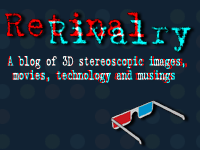I often describe the current landscape of stereographic cinema production to be like the wild west - both a new frontier of boundless possibilities, and a place of conflict, rivalries and lawlessness. Much like North America of the early 1800s, the world of 3-D was first explored and settled by early pioneers. Wheatstone, Brewster, and Holmes made discoveries that launched the 3-D photographic art form, and Lumiere, Friese-Greene, and Land invented new methods to apply stereography to motion pictures. As in the old west, there have been booms and busts - the 3-D successes of the early 1950s and mid 1980s, each followed by a long period of practically no stereo content at all - sort of a 3-D ghost town. And today,we are seeing the mad scramble of the 3-D "gold rush" as every major movie studio, and a lot of minor production companies are staking their claims and seeking to make a fortune in the wake of the success of James Cameron's Avatar.
I recently attended two events that directly addressed this new frontier from completely opposite ends of the spectrum. The first was the 3-D Entertainment Summit, held in Los Angeles, and the second was the World Maker Faire in New York City.
The 3-D Summit was all about the business of 3-D. Presenters gave talks about theatrical box office numbers, acquired versus converted 3-D movies, advertising in stereo, and the future of 3-D in the home market. Keynotes from Dreamworks' Jeffrey Katzenberg and Sony President Chris Cookson stressed that for 3-D to continue to be a premium experience, it must be done right, and support a strong artistic vision. Katzenberg railed against rushed and poorly done 2-D to 3-D conversions, and Cookson noted the importance of education and knowledge in the new technology and language of digital 3-D. (Someone should have pointed this out to guest speaker M. Knight Shyamalan, who repeatedly demonstrated his ignorance of stereography during his session on The Last Airbender)
The thing that struck me about the 3-D Summit was that for all the talk of education and artistic storytelling, the majority of attendees, for the most part, were really only concerned with the bottom line. This was, after all, a business conference, and at over $1,000 a head to attend, an expensive one at that (thankfully I was given my pass by a producer friend who couldn't attend). For the most part people wanted to know what 3-D would cost them, and how much they would profit from it.
A week later, I found myself in New York for the World Maker Faire, put on by the same people who do the Bay Area Maker Faire every year. For the past several years, The LA 3-D Club has been represented at the Bay Area Maker Faire by an ever growing number of members who make the trip up to San Mateo to show their projects at the world's largest Do-It-Yourself science and art festival. This was the first time the event was held in New York, and I was excited to have the opportunity to go to the east coast and participate, particularly when I found out that the Faire was being held at the NY Hall of Science on the grounds of Flushing Meadows - the site of the 1939 World's Fair where the public was first introduced to both polarized 3-D projection and the View Master. I contacted Greg Dinkins, of the New York Stereoscopic Society, and asked him if he would like to join me in the "3-D village". Greg agreed, and enlisted many other talented NYSS members to exhibit their 3-D photos and movies, homemade camera rigs, and other stereoscopic inventions. The thousands of attendees who stopped at our booth seemed genuinely interested in learning about how 3-D works, and specifically about how we each create our art. There was no talk of profit margins or ticket markups - this was 3-D solely for the creative vision.
I always find it very interesting moving back and forth between the worlds of the motion picture industry and the independent artists, and getting their varied perspectives on the state of 3-D. I just hope that in this new frontier, there's room for both the cattle barons and the cowboys.
Subscribe to:
Post Comments (Atom)

No comments:
Post a Comment